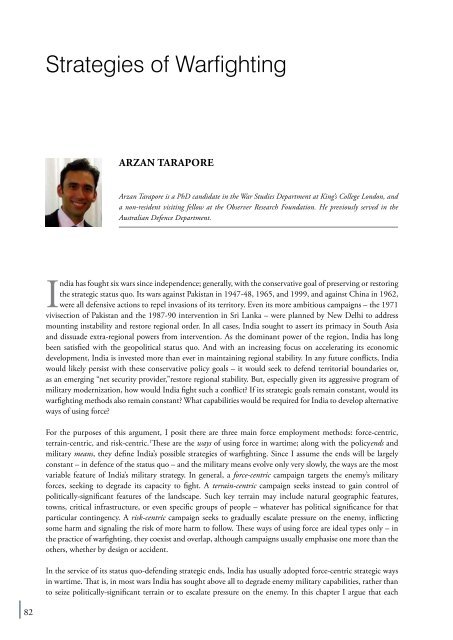Defence Primer
Military_Layout
Military_Layout
Create successful ePaper yourself
Turn your PDF publications into a flip-book with our unique Google optimized e-Paper software.
Strategies of Warfighting<br />
Arzan Tarapore<br />
Arzan Tarapore is a PhD candidate in the War Studies Department at King’s College London, and<br />
a non-resident visiting fellow at the Observer Research Foundation. He previously served in the<br />
Australian <strong>Defence</strong> Department.<br />
India has fought six wars since independence; generally, with the conservative goal of preserving or restoring<br />
the strategic status quo. Its wars against Pakistan in 1947-48, 1965, and 1999, and against China in 1962,<br />
were all defensive actions to repel invasions of its territory. Even its more ambitious campaigns – the 1971<br />
vivisection of Pakistan and the 1987-90 intervention in Sri Lanka – were planned by New Delhi to address<br />
mounting instability and restore regional order. In all cases, India sought to assert its primacy in South Asia<br />
and dissuade extra-regional powers from intervention. As the dominant power of the region, India has long<br />
been satisfied with the geopolitical status quo. And with an increasing focus on accelerating its economic<br />
development, India is invested more than ever in maintaining regional stability. In any future conflicts, India<br />
would likely persist with these conservative policy goals – it would seek to defend territorial boundaries or,<br />
as an emerging “net security provider,”restore regional stability. But, especially given its aggressive program of<br />
military modernization, how would India fight such a conflict? If its strategic goals remain constant, would its<br />
warfighting methods also remain constant? What capabilities would be required for India to develop alternative<br />
ways of using force?<br />
For the purposes of this argument, I posit there are three main force employment methods: force-centric,<br />
terrain-centric, and risk-centric. 1 These are the ways of using force in wartime; along with the policyends and<br />
military means, they define India’s possible strategies of warfighting. Since I assume the ends will be largely<br />
constant – in defence of the status quo – and the military means evolve only very slowly, the ways are the most<br />
variable feature of India’s military strategy. In general, a force-centric campaign targets the enemy’s military<br />
forces, seeking to degrade its capacity to fight. A terrain-centric campaign seeks instead to gain control of<br />
politically-significant features of the landscape. Such key terrain may include natural geographic features,<br />
towns, critical infrastructure, or even specific groups of people – whatever has political significance for that<br />
particular contingency. A risk-centric campaign seeks to gradually escalate pressure on the enemy, inflicting<br />
some harm and signaling the risk of more harm to follow. These ways of using force are ideal types only – in<br />
the practice of warfighting, they coexist and overlap, although campaigns usually emphasise one more than the<br />
others, whether by design or accident.<br />
In the service of its status quo-defending strategic ends, India has usually adopted force-centric strategic ways<br />
in wartime. That is, in most wars India has sought above all to degrade enemy military capabilities, rather than<br />
to seize politically-significant terrain or to escalate pressure on the enemy. In this chapter I argue that each<br />
82


